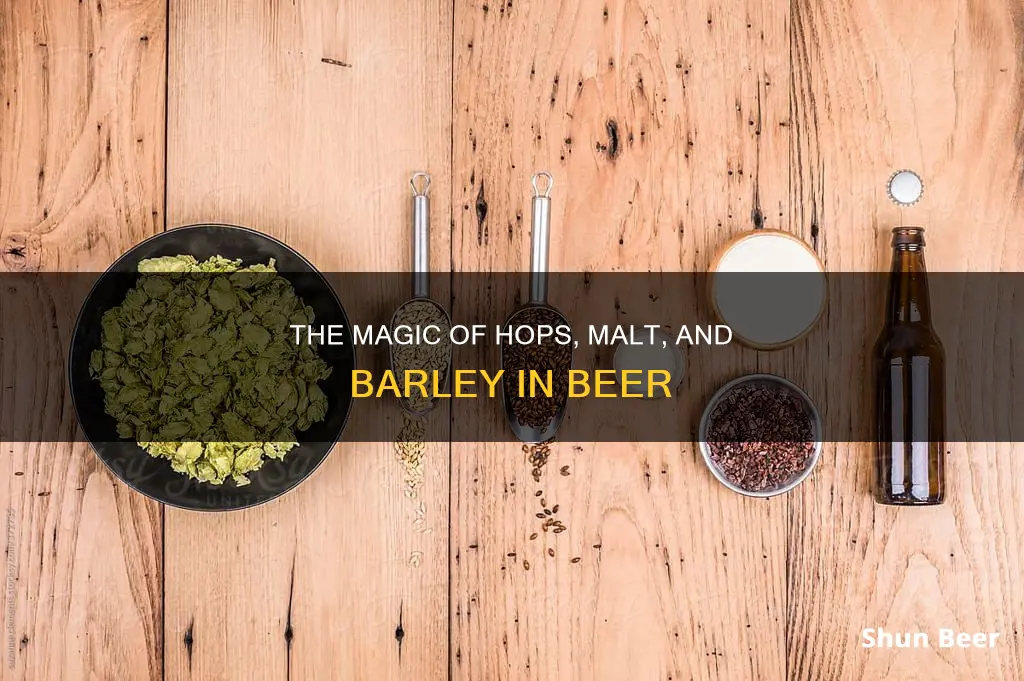
Hops, malt and barley are three of the four main ingredients in beer, the fourth being water. Barley must be malted before it can be used to make beer, which involves a natural conversion process. The barley is soaked in water and then drained, causing it to sprout. The sprouting activates enzymes that convert the starches in the barley into sugars, which can then be fermented by yeast to create alcohol and CO2. Hops are added to provide bitterness, flavour and aroma, and to inhibit the formation of bacteria that can spoil the beer. They are the flowers of a vine in the hemp family, closely related to cannabis.
| Characteristics | Values |
|---|---|
| Malt | Adds colour, flavour, and sugar content to unfermented beer |
| Malt | Produced by malting grains such as barley, wheat, rye, and oats |
| Malt | Provides the sugars that are fermented by the yeast to create alcohol and CO2 |
| Malt | Determines the colour of the beer |
| Hops | Provide bitterness to balance the sweetness of the malt |
| Hops | Provide flavours and aromas ranging from citrus and pine to earthy and spicy |
| Hops | Inhibit the formation of certain bacteria that can spoil the beer |
| Hops | Promote foam formation |
| Hops | Provide preservative properties to beer |
| Barley | The seed of a grain that looks similar to wheat |
| Barley | Must be malted before being used to make beer |
| Barley | Provides the sugars that are converted into alcohol |
What You'll Learn
- Hops give beer its bitterness, flavour, aroma, and preservative properties
- Malted barley is the brewer's preferred grain for making beer
- Malted grains provide the sugars that are fermented by yeast to create alcohol and CO2
- Hops are added during the boiling stage to give the beer its desired taste, colour, and improved shelf life
- Barley must be malted before it can be used to make beer

Hops give beer its bitterness, flavour, aroma, and preservative properties
Hops are an essential ingredient in beer, adding bitterness, flavour, aroma, and preservative properties. They are the flowers of a vine in the hemp family, closely related to cannabis. Hops contain alpha acids, which lend beer its bitterness, and oils that contribute to its flavour and aroma. The hops vine also contains resins, which are vital for beer-making.
The hops used in beer are the flower of the hop vine, which is a member of the hemp family, including cannabis and marijuana. However, unlike its psychoactive relatives, hops do not have mind-altering effects. The hops plant contains oils and resins, which contribute to the unique characteristics of beer.
The bitterness of beer depends on the type of hops used, the amount added, and the boiling time. Hops are boiled to allow the alpha acids to undergo chemical changes that bitter the beer. The longer the hops are boiled, the more bitter the beer will become.
Different types of hops impart different flavours, such as citrus, pine, floral, fruity, earthy, and spicy notes. The growing region also influences the flavour and aroma characteristics of hops, with popular regions including the US, Southern England, Germany, the Czech Republic, and China.
In addition to enhancing the flavour profile of beer, hops also act as a preservative. They inhibit the formation of certain bacteria that can spoil the beer, thus improving its shelf life.
Hops and Hues: Unveiling the Color Mystery in Beer Brewing
You may want to see also

Malted barley is the brewer's preferred grain for making beer
Malting is one of the most fascinating yet least celebrated steps in brewing. It involves multiple steps, including steeping, germinating, and roasting. The process begins by soaking either two-row or six-row barley in steeping tanks for a couple of days. The barley is then transferred to a room where it is aerated, turned regularly, and held at around 60°F (15.5°C) to encourage germination. This process opens up the barley husk, making it more open to the fermentation process. At this stage, it is called "green malt".
The trick is to prevent the barley from sprouting too much. After about five days of soaking, the grain will want to take root and grow a new plant. Maltsters, the skilled people in charge of malting, stop the germination process by applying heat. They kiln, or dry, the green malt by slowly raising the temperature to more than 120°F. The final temperature depends on the desired type of malt.
The result of this process is a dried barley grain full of sugar, starch, and an enzyme called diastase. The level of heat applied to the green malt plays a significant role in determining the final style of beer produced. Lower temperatures are used for pale-coloured beers like pale ales and lagers, while higher temperatures create darker beers such as brown ales, porters, and stouts.
After the malted barley is produced, it is transferred to the brewery, where the brewer adds the grain to hot water, known as "strike water". This encourages the diastase to convert starch into simple sugars, which dissolve in the hot water to create wort, marking the beginning of the fermentation process.
Malted barley is the brewer's preferred grain because it adds colour, flavour, and sugar content to the beer. It is the primary source of beer colour and significantly contributes to flavour and mouthfeel. The malting process allows brewers to control the sprouting and kilning of the grains, influencing the colour and flavour of the final product.
Beer Hops Allergy: What You Need to Know
You may want to see also

Malted grains provide the sugars that are fermented by yeast to create alcohol and CO2
Malted grains are an essential ingredient in beer. They add colour, flavour, and sugar content to unfermented beer. Malt is a grain that has been specially prepared for brewing beer and is the reason for the delicious golden colour of the beverage. The malting process involves multiple steps, including steeping, germinating, and roasting. The prepared malt is then ground and mixed with clean water. The quality of the water largely determines the quality and taste of the beer.
The mixture of water and malt is then heated to different temperatures. During fermentation, the starch contained in the malt is broken down into sugars, which are then converted into alcohol. This is where the magic happens: the sugars derived from the malt provide all the food that yeast will consume and convert into alcohol (ethyl alcohol) and carbon dioxide.
Malted grains, typically barley, are the primary source of fermentable sugars in beer. The malting process involves controlled sprouting and kilning of the grains. The sprouting activates enzymes within the grain that begin to break down the hard, starchy insides into simpler carbohydrates, making them accessible to the brewer. The starches are converted into sugars that can be fermented by yeast to create alcohol and carbon dioxide.
The level of heat that the malt is subjected to during the kilning process will play a significant role in determining the final style of beer produced. Lower temperatures will form the base for pale-coloured beers, such as pale ales and lagers. Increasing the temperature will produce amber-coloured beers, and even higher temperatures will result in dark brown beers. The highest temperatures are used to create the darkest, almost black, beers, such as porters and stouts.
Hops in Beer: Vegetable or Not?
You may want to see also

Hops are added during the boiling stage to give the beer its desired taste, colour, and improved shelf life
Hops are an essential ingredient in beer, alongside malt, barley, yeast, and water. Hops are added during the boiling stage to give the beer its desired taste, colour, and improved shelf life.
Hops are the flowers of a vine in the cannabis family, and they are closely related to marijuana. They contain alpha acids, oils, and resins that contribute to the overall character of the beer. The alpha acids give beer its bitterness, while the oils provide flavour and aroma. Hops with different flavours include citrus, pine, floral, fruit, and spicy.
During the boiling process, the alpha acids in the hops undergo chemical changes that allow them to bitter the beer. The longer the hops are boiled, the more bitterness is imparted to the beer. Therefore, the desired level of bitterness can be achieved by adjusting the boiling time.
In addition to flavour and bitterness, hops also act as a preservative. They inhibit the formation of certain bacteria that can spoil the beer, thus improving its shelf life.
The role of hops in the brewing process is crucial for balancing the flavours and aromas of the beer. Without hops, beer would be too sweet. By adding hops during the boiling stage, brewers can fine-tune the desired taste, colour, and shelf life of the final product.
Belgian Beer and Hops: A Complex Relationship
You may want to see also

Barley must be malted before it can be used to make beer
Barley is a seed that looks similar to wheat. It is one of the four primary ingredients in beer, the others being water, hops, and yeast. Before barley can be used to make beer, it must undergo a process called malting. This involves a natural conversion process, where the barley is soaked in water for several days, drained, and then held at around 60 degrees Fahrenheit (15.5 degrees Celsius) for about five days. This temperature is maintained to allow the barley to germinate or start to sprout, opening up the husk. At this stage, the barley is called "green malt".
During germination, enzymes are released by the barley plant, which convert the starches inside the grain into sugars. The key is to stop the germination process at a point when the sugar-producing enzymes are present, but most of the starch remains unconverted. The green malt is then dried by gradually increasing the temperature, with the intensity of the malt flavor and color dependent on the temperature reached. The final step involves removing any small roots that may have formed during germination, and the malted barley is then ready for brewing.
The malting process is a crucial step in preparing the barley for beer-making, as it converts the starches in the barley into sugars that will eventually feed the yeast and facilitate the production of alcohol during fermentation. Without malting, the barley would not be suitable for brewing, and the beer-making process could not proceed.
Identifying Hops in Beer: A Guide to Flavor and Aroma
You may want to see also
Frequently asked questions
Malt is any type of grain that has been prepared for brewing beer. The most common type of malt is barley malt, but other grains such as wheat, rye, and oats can also be used. The malting process involves soaking the grain in water, allowing it to germinate, and then drying it. This process converts the starches in the grain into fermentable sugars, which are essential for the fermentation process that creates alcohol.
Barley is one of the main ingredients in beer. Before it can be used, barley must undergo the malting process described above. This process converts the starches in the barley into sugars, which will eventually be fermented into alcohol.
Hops are essential for adding bitterness, aroma, and preservative properties to beer. They also help to balance the sweetness of the malt. Hops contain alpha acids and oils that give beer its unique characteristics. Different types of hops have different flavours, ranging from citrus and pine to earthy and spicy.







